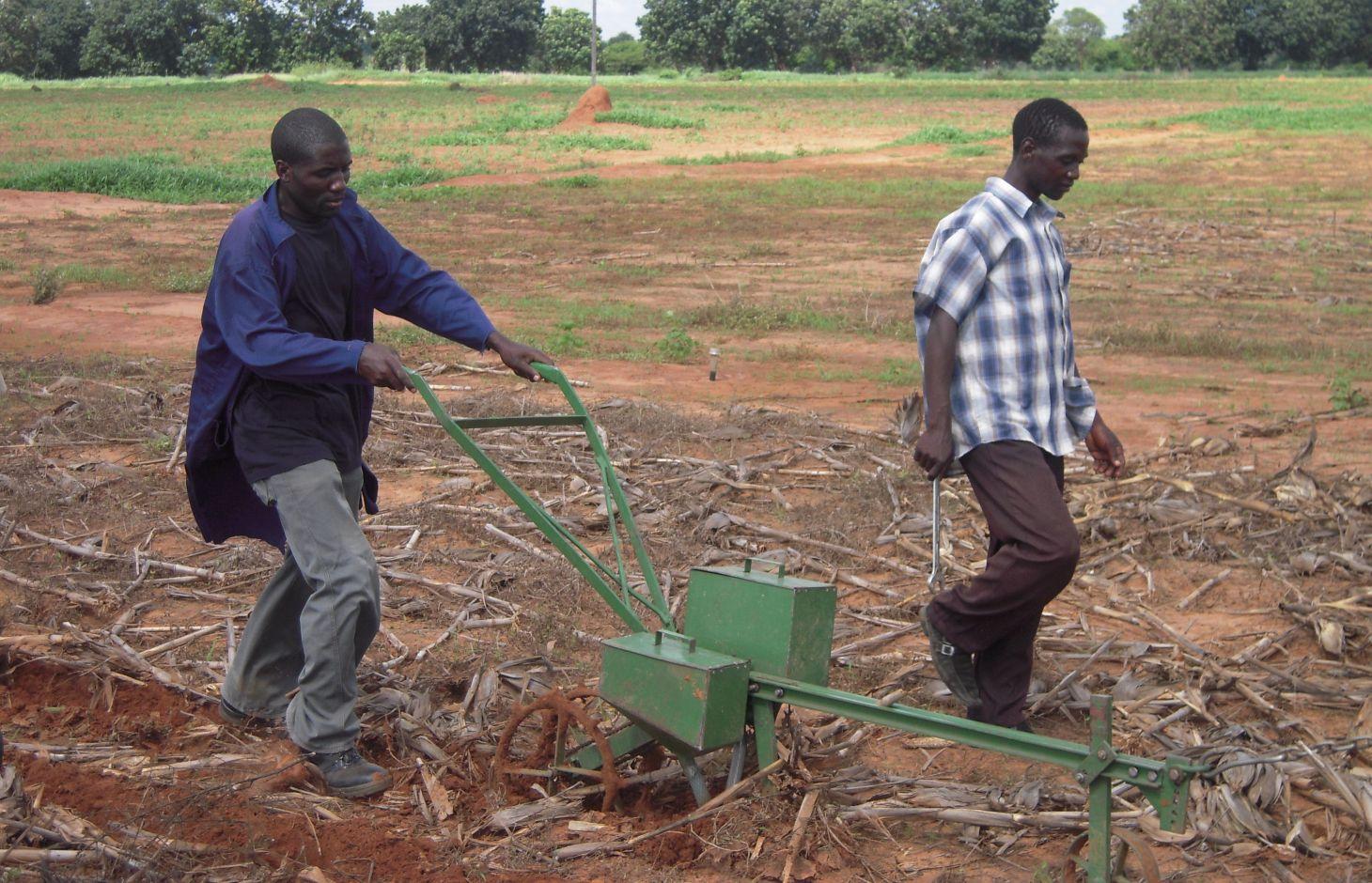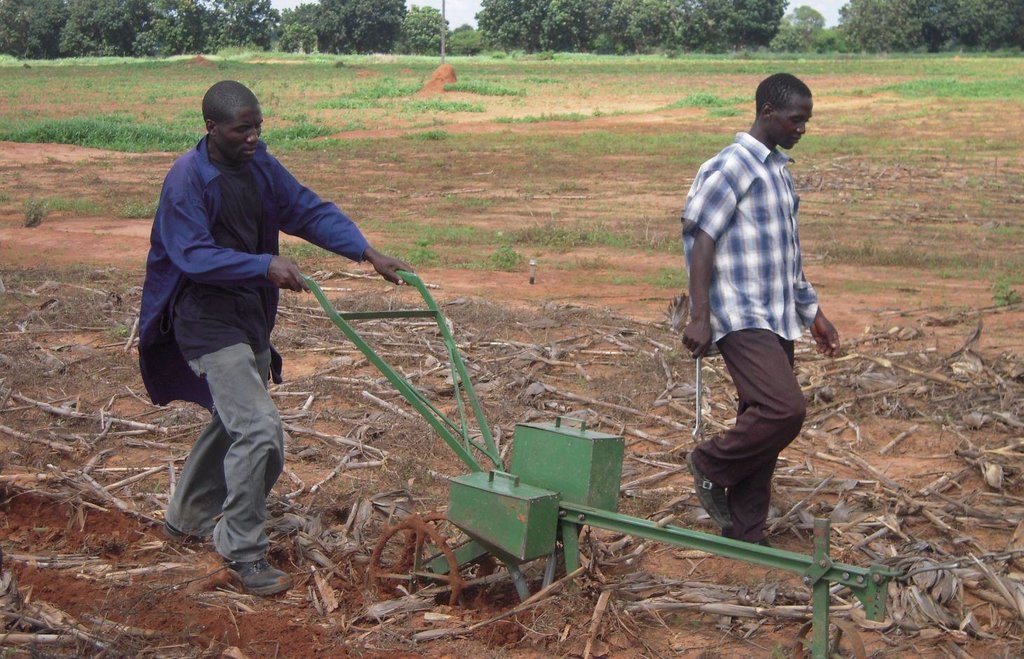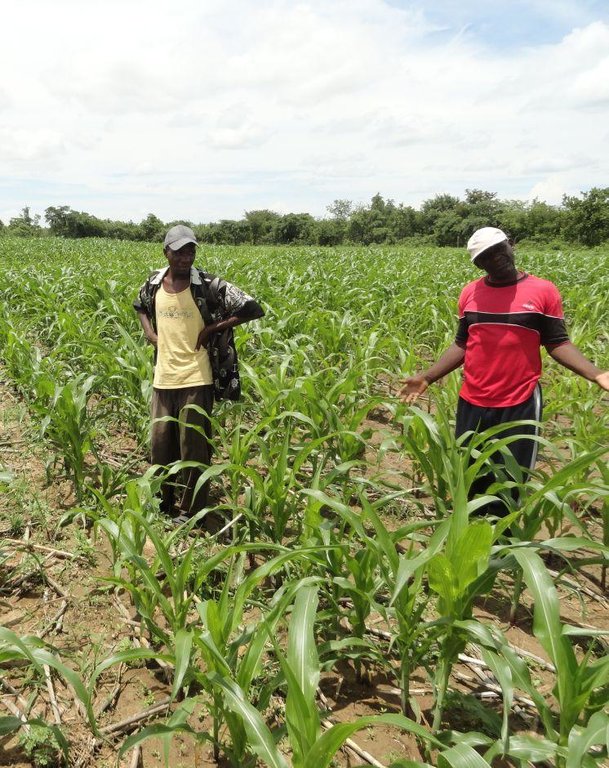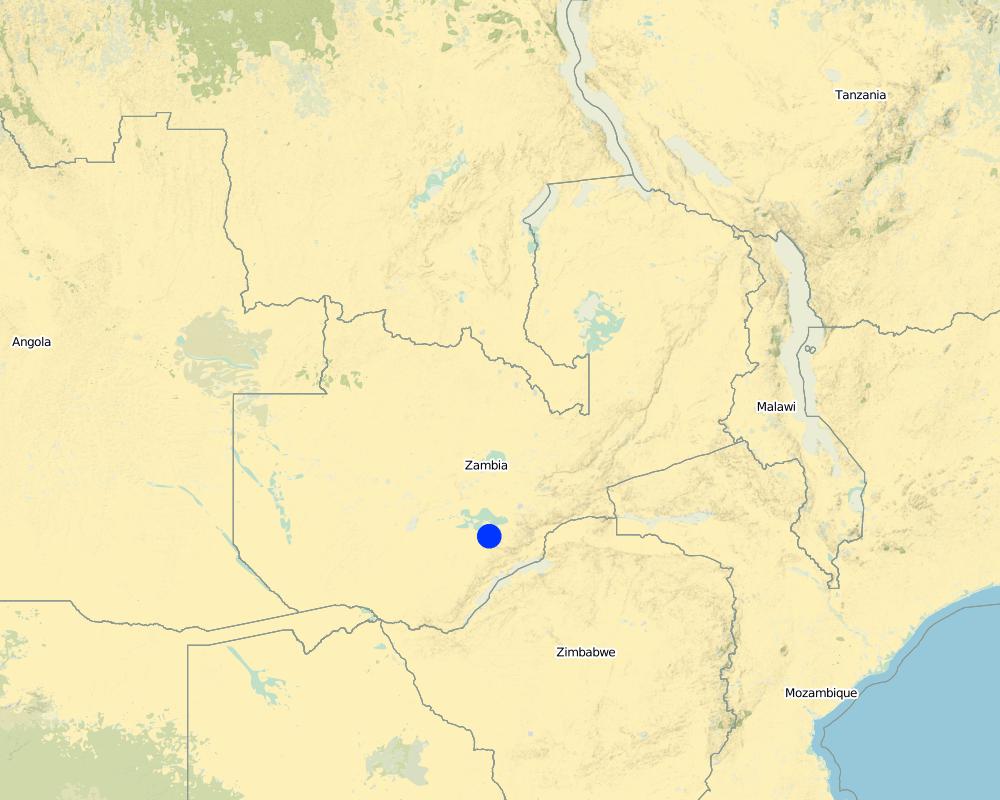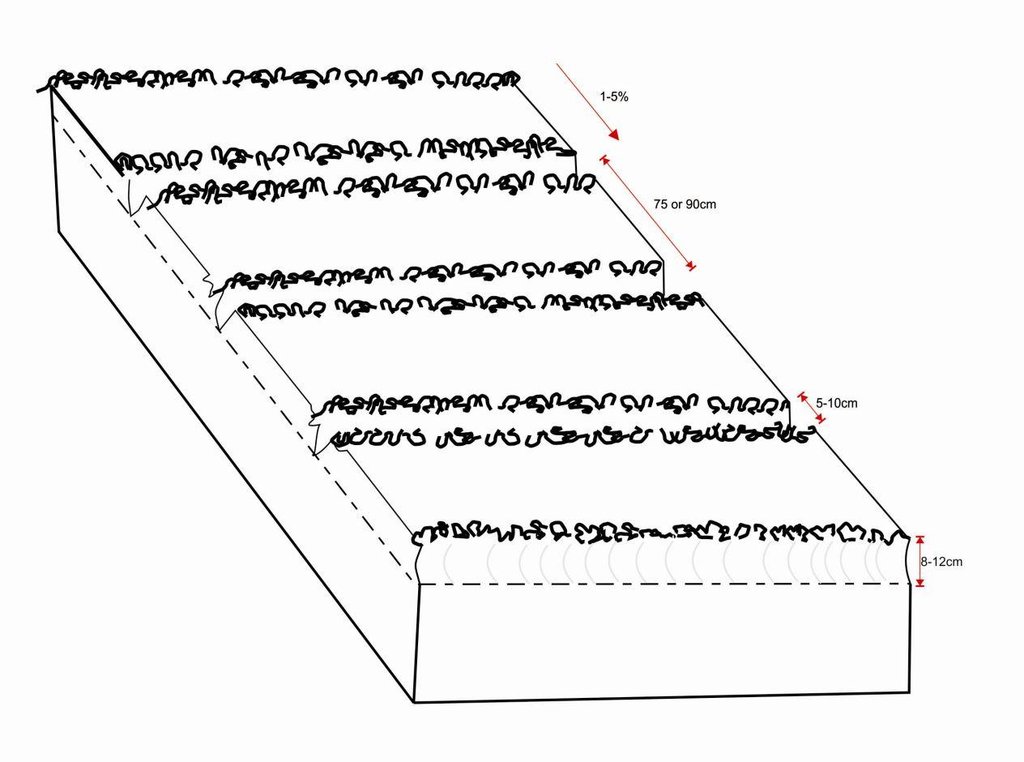Animal Draft Zero-Tillage [Zâmbia]
- Criação:
- Atualização:
- Compilador/a: Silenga Wamunyima
- Editor: –
- Revisores: Alexandra Gavilano, Fabian Ottiger
Direct Planting
technologies_1140 - Zâmbia
Veja as seções
Expandir tudo Recolher tudo1. Informação geral
1.2 Detalhes do contato das pessoas capacitadas e instituições envolvidas na avaliação e documentação da tecnologia
Especialista em GST:
Katoweji Alfred
Golden Valley Agricultural Research Trust
Zâmbia
Especialista em GST:
Ndandula Sharon
Golden Valley Agricultural Research Trust
Zâmbia
Nome da(s) instituição(ões) que facilitou(ram) a documentação/ avaliação da Tecnologia (se relevante)
Golden Valley agricultural research trust (Golden Valley agricultural research trust) - Zâmbia1.3 Condições em relação ao uso da informação documentada através de WOCAT
O/a compilador/a e a(s) pessoa(s) capacitada(s) aceitam as condições relativas ao uso de dados documentados através da WOCAT:
Sim
1.5 Referência ao(s) questionário(s) sobre abordagens GST (documentado(s) usando WOCAT)
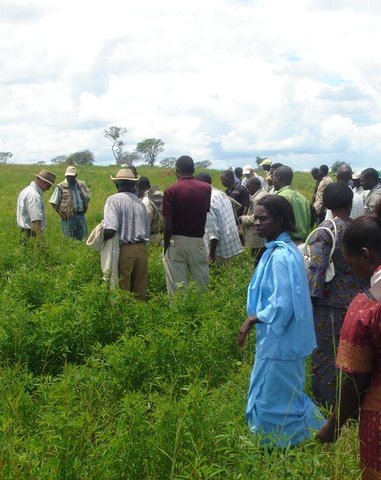
Participatory Research and Development [Zâmbia]
This is a collaborative process between researchers and farmers for developing and adapting new technologies that focus on incorporating the perspectives and inputs from the farmers into the development process.
- Compilador/a: Arthur Chomba
2. Descrição da tecnologia de GST
2.1 Descrição curta da tecnologia
Definição da tecnologia:
Animal draft zero-till involves the use of an animal drawn mechanical planter to plant directly in untilled soil to minimize soil disturbance and leave a cover of crop residues to conserve the soil and water.
2.2 Descrição detalhada da tecnologia
Descrição:
Zero-tillage takes advantage of the beneficial effects of biological processes to loosen the soil and to improve fertility. The organic matter from these processes aggregate the soil while the movement of soil organisms like worms and termites loosen the soil. This is called biological tillage and replaces mechanical tillage. The untilled soil surface covered by residues will require a planter specialized to plant in these conditions. In a sense, adopting zero-till does actually require a zero-till planter. The development of the strip-planter has made zero-till a viable option for animal draft farmers, which until now was not possible due to the unavailability or high cost of zero-till planters. The new planter is both cheap and easy to manufacture locally. The planter uses a narrow tine to open a planting furrow and seed/fertilizer is metered by vertically rotating plates. The planter is pulled by oxen and can plant rows of 75cm or 90cm rows with an intra-row which is determined by the seed plate used (3, 4, 5,…… seeds/m). The planting technology needs to be complemented with sound residue cover and weeding management practices.
Purpose of the Technology: The planter enables planting and fertilizing in untilled soil so that the soil residue cover and soil structure are preserved and can be used sustainably. The protective soil cover reduces evaporation and enhances infiltration while the improved soil structure and organic matter content increases soil water storage making zero tillage an important drought mitigating strategy. The immediate benefits of adopting zero-till are the possibility to plant a bigger area quickly and in time as well as the reduced soil erosion.
Establishment / maintenance activities and inputs: The first step in establishing zero-till is to assess the soil condition and levels of degradation. Where possible tests should be carried out but where not, the farmer needs to start on a small plot to check if there will be yield reduction from not tilling the soil. Where soils are severely degraded, an establishment phase should be embarked on where reduced tillage is practiced until the soil structure has recovered sufficiently to support crop growth without tillage. Liming acidic soils followed by a final ploughing will be required in the first year to correct the soil pH which otherwise will be difficult to correct once conservation tillage has been established. The organic matter levels need to be increased by increasing the amount of residues produced by the crop (i.e. the yields) and retaining these as soil cover. The next establishment activity is the purchase of the planter unit. Maintenance activities include planting and fertilizing in the same operation and weeding. Weeding will have to involve herbicide use to handle increased weed densities implying that spraying will become a major operation. In addition to the normal conventional inputs, herbicides will also become a major input and cost.
Natural / human environment: Zero-till has been applied in a wide range of bio-physical environments but mostly by the large scale farmers. The unavailability and high cost of specialized zero-till planter for small-scale farming has resulted in low adoption rates. The development of the Magoye Planter creates new opportunities for this practice. The farmer has to have sufficient knowledge to assess the soil condition and decide if is too degraded for zero-till or how long the transitional phase should be. Literacy is essential as the farmers will have to learn new approaches on weed control, pest control and crop rotations and adapt practices to suit his/her specific conditions.
2.3 Fotos da tecnologia
2.5 País/região/locais onde a tecnologia foi aplicada e que estão cobertos nesta avaliação
País:
Zâmbia
Região/Estado/Província:
Zambia/Southern Province
Especificação adicional de localização:
Mazabuka/Magoye
Comentários:
Total area covered by the SLM Technology is 0.56 km2.
Zero-Till with the Magoye planter technology was introduced in 2011 and is only in its second season of use. Only four farmers have adopted the technology although it has not yet been officially launched and promoted.
Map
×2.6 Data da implementação
Caso o ano exato seja desconhecido, indique a data aproximada:
- menos de 10 anos atrás (recentemente)
2.7 Introdução da tecnologia
Especifique como a tecnologia foi introduzida:
- durante experiências/ pesquisa
Comentários (tipos de projeto, etc.):
Development of the Magoye planter began in 2008 in response to farmers’ feedback on the Magoye Ripper. Farmers started adopting the technology in 2011
3. Classificação da tecnologia de GST
3.2 Tipo(s) atualizado(s) de uso da terra onde a tecnologia foi aplicada

Terra de cultivo
- Cultura anual
Cultivo anual - Especificar culturas:
- cereais - milho
- Annual cropping is the main source of livelihood.
Número de estações de cultivo por ano:
- 1
Especifique:
Longest growing period in days: 135Longest growing period from month to month: mid Nov to end of March

Pastagem
Pastagem extensiva:
- Pastoralismo semi-nômade
- Nearly half of the farmers own cattle but these are not sold regularly, only for school fees and ceremonies. Livestock is grazing on crop residues
Comentários:
Livestock density (if relevant):
1-10 LU /km2
Major land use problems (compiler’s opinion): Loss of soil structure and low soil fertility
Major land use problems (land users’ perception): Droughts and dry spell
3.4 Abastecimento de água
Abastecimento de água para a terra na qual a tecnologia é aplicada:
- Precipitação natural
3.6 Medidas de GST contendo a tecnologia

Medidas agronômicas
- A1: cobertura vegetal/do solo
- A2: Matéria orgânica/fertilidade do solo
- A3: Tratamento da superfície do solo
- A4: Tratamento do subsolo
- A5: Gestão de sementes, variedades melhoradas
- A6: Gerenciamento de resíduos
- A7: Outros
A3: Diferenciar os sistemas de lavoura:
A 3.1: Sem lavoura
Comentários:
Specification of other agronomic measures: Zero till, Crop residue
Type of agronomic measures: early planting, mulching, manure / compost / residues, mineral (inorganic) fertilizers, soil conditioners (lime, gypsum), zero tillage / no-till
3.7 Principais tipos de degradação da terra abordados pela tecnologia

Erosão do solo pela água
- Wt: Perda do solo superficial/erosão de superfície

Deteriorização química do solo
- Cn: declínio de fertilidade e teor reduzido de matéria orgânica (não causado pela erosão)

Deteriorização física do solo
- Pk: quebra e ressecamento

Degradação biológica
- Bl: perda da vida do solo
Comentários:
Main causes of degradation: soil management (Overploughing, soil nutrient mining), crop management (annual, perennial, tree/shrub) (Monocropping), overgrazing (Overgrazing of crop residues), poverty / wealth (Charcoal burning, under application of fertilizer), inputs and infrastructure: (roads, markets, distribution of water points, other, …) (high cost of fertilizer)
Secondary causes of degradation: deforestation / removal of natural vegetation (incl. forest fires) (Charcoal burning), Heavy / extreme rainfall (intensity/amounts) (Overgrazing of crop residues), droughts, land tenure (Communal land overexploited), education, access to knowledge and support services (inadequate extension staff), governance / institutional (lack of credit facilities)
3.8 Redução, prevenção ou recuperação da degradação do solo
Especifique o objetivo da tecnologia em relação a degradação da terra:
- Prevenir degradação do solo
- Reduzir a degradação do solo
Comentários:
Secondary goals: rehabilitation / reclamation of denuded land
4. Especificações técnicas, implementação de atividades, entradas e custos
4.1 Desenho técnico da tecnologia
Especificações técnicas (relacionada ao desenho técnico):
Planting lines are done at a depth of 8-12cm with inter row of 75 or 90cm. The width of the open furrow is 5-10cm wide. Planting rows are done across the slope to reduce runoff, these planting rows are done when the soil is moist during the rainy season and planting is done at the same time with land preparation. Farmers in Monze have combined ripping and zero till together. In the dry season they rip with the Magoye Ripper or GART Planter and later when the soil is moist use a zero till implement to plant.
Location: Magoye. Mazabuka/Southern Province/Zambia
Date: 2014-06-29
Technical knowledge required for field staff / advisors: high (This is a new technology and the extension staff must be able to help farmers troubleshoot and adapt the technology to local conditions.)
Technical knowledge required for land users: moderate (The farmers have to adopt new soil management practices, crop rotations and adapt the weeding approaches to complement the planting technology)
Main technical functions: improvement of surface structure (crusting, sealing), improvement of topsoil structure (compaction), increase of infiltration, increase / maintain water stored in soil
Secondary technical functions: control of raindrop splash, improvement of ground cover, improvement of subsoil structure (hardpan), increase in organic matter, increase in nutrient availability (supply, recycling,…), increase of groundwater level / recharge of groundwater, water harvesting / increase water supply, improvement of water quality, buffering / filtering water
Early planting
Material/ species: maize
Quantity/ density: 44,000 pla
Remarks: 25cm intra row by 75cm
Mulching
Material/ species: crop residues
Quantity/ density: 3ton/ha
Remarks: uniformly spread
Manure / compost / residues
Material/ species: crop residues
Quantity/ density: 3ton/ha
Remarks: uniformly spread
Mineral (inorganic) fertilizers
Material/ species: basal and top dressing
Quantity/ density: 400kg/ha
Remarks: spot application
Soil conditioners (lime, gypsum)
Material/ species: lime
Quantity/ density: 1ton/ha
Remarks: broadcast
Autor:
Silenga Wamunyima, Box 670577, Mazabuka, Zambia
4.2 Informação geral em relação ao cálculo de entradas e custos
Outro/moeda nacional (especifique):
Kwacha
Se for relevante, indique a taxa de câmbio do USD para moeda local (por exemplo, 1 USD = 79,9 Real): 1 USD =:
5,0
Indique a média salarial da mão-de-obra contratada por dia:
2.40
4.3 Atividades de implantação
| Atividade | Periodicidade (estação do ano) | |
|---|---|---|
| 1. | Purchase a magoye planter | |
| 2. | Purchase a knapsack sprayer |
Comentários:
Life span of the magoye planter: 15 years
Life span of the knapsack sprayer: 5 years
4.4 Custos e entradas necessárias para a implantação
| Especifique a entrada | Unidade | Quantidade | Custos por unidade | Custos totais por entrada | % dos custos arcados pelos usuários da terra | |
|---|---|---|---|---|---|---|
| Equipamento | Magoye Planter | piece | 1,0 | 500,0 | 500,0 | 100,0 |
| Equipamento | Knapsack sprayer | piece | 1,0 | 80,0 | 80,0 | 100,0 |
| Custos totais para a implantação da tecnologia | 580,0 | |||||
| Custos totais para o estabelecimento da Tecnologia em USD | 116,0 | |||||
Comentários:
Duration of establishment phase: 2 month(s)
4.5 Atividades recorrentes/manutenção
| Atividade | Periodicidade/frequência | |
|---|---|---|
| 1. | Slashing, spreading residues | May-June every year after harvest |
| 2. | Liming | Nov - Dec every 3years |
| 3. | Planting and fertilizing | Nov-Dec at onset of rain |
| 4. | Chemical weeding | 3 times per growing season |
| 5. | Harvesting | May-June |
4.6 Custos e entradas necessárias pata a manutenção/atividades recorrentes (por ano)
| Especifique a entrada | Unidade | Quantidade | Custos por unidade | Custos totais por entrada | % dos custos arcados pelos usuários da terra | |
|---|---|---|---|---|---|---|
| Mão-de-obra | Slashing, spreading residues | person days | 8,0 | 2,5 | 20,0 | 100,0 |
| Mão-de-obra | Liming | person days | 2,0 | 2,5 | 5,0 | 100,0 |
| Mão-de-obra | Chemical weeding | person days | 24,0 | 1,0 | 24,0 | 100,0 |
| Mão-de-obra | Harvesting | person days | 8,0 | 2,5 | 20,0 | 100,0 |
| Equipamento | Animal traction for planting and fertilizing | ha | 1,0 | 40,0 | 40,0 | 100,0 |
| Material vegetal | Seeds | kg | 20,0 | 2,5 | 50,0 | 100,0 |
| Material vegetal | Fertilizer | kg | 400,0 | 0,8 | 320,0 | 100,0 |
| Material vegetal | Herbicides | l | 5,0 | 6,0 | 30,0 | 100,0 |
| Material vegetal | Lime | ton | 1,0 | 42,0 | 42,0 | 100,0 |
| Custos totais para a manutenção da tecnologia | 551,0 | |||||
| Custos totais de manutenção da Tecnologia em USD | 110,2 | |||||
Comentários:
Machinery/ tools: The Magoye planter
Calculation are for 1ha of maize under strip tillage based conservation tillage and costs are for the Zambia situation in Magoye as of August 2012.
4.7 Fatores mais importantes que afetam os custos
Descreva os fatores mais determinantes que afetam os custos:
The weed control method is the main determinate factor depending on whether the farmer uses hand hoe or herbicides. Weed densities are higher in unploughed fields increasing the labour requirements/costs by a factor of about 5 if hand weeding is used instead of herbicides. Another major cost is that of fertilizer which makes up about half the cost hence the total cost will vary significantly depending on fertilizer cost.
5. Ambiente natural e humano
5.1 Clima
Precipitação pluviométrica anual
- <250 mm
- 251-500 mm
- 501-750 mm
- 751-1.000 mm
- 1.001-1.500 mm
- 1.501-2.000 mm
- 2.001-3.000 mm
- 3.001-4.000 mm
- > 4.000 mm
Zona agroclimática
- Semiárido
Thermal climate class: subtropics. 3 distinct seasons – summer, winter and one rainy season
5.2 Topografia
Declividade média:
- Plano (0-2%)
- Suave ondulado (3-5%)
- Ondulado (6-10%)
- Moderadamente ondulado (11-15%)
- Forte ondulado (16-30%)
- Montanhoso (31-60%)
- Escarpado (>60%)
Formas de relevo:
- Planalto/planície
- Cumes
- Encosta de serra
- Encosta de morro
- Sopés
- Fundos de vale
Zona de altitude:
- 0-100 m s.n.m.
- 101-500 m s.n.m.
- 501-1.000 m s.n.m.
- 1.001-1.500 m s.n.m.
- 1.501-2.000 m s.n.m.
- 2.001-2.500 m s.n.m.
- 2.501-3.000 m s.n.m.
- 3.001-4.000 m s.n.m.
- > 4.000 m s.n.m.
5.3 Solos
Profundidade do solo em média:
- Muito raso (0-20 cm)
- Raso (21-50 cm)
- Moderadamente profundo (51-80 cm)
- Profundo (81-120 cm)
- Muito profundo (>120 cm)
Textura do solo (solo superficial):
- Médio (limoso, siltoso)
- Fino/pesado (argila)
Matéria orgânica do solo superficial:
- Baixo (<1%)
5.4 Disponibilidade e qualidade de água
Lençol freático:
> 50 m
Disponibilidade de água de superfície:
Médio
Qualidade da água (não tratada):
Água potável precária (tratamento necessário)
5.6 Características dos usuários da terra que utilizam a tecnologia
Rendimento não agrícola:
- 10-50% de toda renda
Nível relativo de riqueza:
- Muito pobre
- Pobre
Indivíduos ou grupos:
- Indivíduo/unidade familiar
Gênero:
- Homens
Indique outras características relevantes dos usuários da terra:
Land users applying the Technology are mainly common / average land users
Difference in the involvement of women and men: The technology is applied mostly by men since most households are male headed and animal traction operation are reserved for men
Population density: 10-50 persons/km2
Annual population growth: 3% - 4%
8% of the land users are rich and own 15% of the land (own more than 10 cattle).
8% of the land users are average wealthy and own 15% of the land (own between 5 and 10 cattle).
16% of the land users are poor and own 20% of the land (own less than 5 cattle).
68% of the land users are poor and own 40% of the land (do not own cattle).
Off-farm income specification: sale of rainfed crops makes up about half of their income, the remainder coming from sale of livestock, petty trading, hiring out labour and remittances
Market orientation of production system: subsistence (self-supply), subsistence (self-supply), mixed (subsistence/ commercial
5.7 Área média de terrenos utilizados pelos usuários de terrenos que aplicam a Tecnologia
- < 0,5 ha
- 0,5-1 ha
- 1-2 ha
- 2-5 ha
- 5-15 ha
- 15-50 ha
- 50-100 ha
- 100-500 ha
- 500-1.000 ha
- 1.000-10.000 ha
- > 10.000 ha
É considerado pequena, média ou grande escala (referente ao contexto local)?
- Pequena escala
Comentários:
Average area of land owned or leased by land users applying the Technology: 1-2 ha, 2-5 ha, 5-15 ha, 5-15 ha, 15-50 ha, 15-50 ha, 50-100 ha
5.8 Propriedade de terra, direitos de uso da terra e de uso da água
Propriedade da terra:
- Indivíduo, não intitulado
Direitos do uso da terra:
- Acesso livre (não organizado)
- Indivíduo
- Land is apportioned by traditional leaders
Direitos do uso da água:
- Acesso livre (não organizado)
- Land is apportioned by traditional leaders
5.9 Acesso a serviços e infraestrutura
Saúde:
- Pobre
- Moderado
- Bom
Educação:
- Pobre
- Moderado
- Bom
Assistência técnica:
- Pobre
- Moderado
- Bom
Emprego (p. ex. não agrícola):
- Pobre
- Moderado
- Bom
Mercados:
- Pobre
- Moderado
- Bom
Energia:
- Pobre
- Moderado
- Bom
Vias e transporte:
- Pobre
- Moderado
- Bom
Água potável e saneamento:
- Pobre
- Moderado
- Bom
Serviços financeiros:
- Pobre
- Moderado
- Bom
6. Impactos e declarações finais
6.1 Impactos no local mostrados pela tecnologia
Impactos socioeconômicos
Produção
Produção agrícola
Produção de forragens
Risco de falha de produção
Área de produção
Quantidade anterior à GST:
2-3ha
Quantidade posterior à GST:
>10
Renda e custos
Rendimento agrícola
Diversidade de fontes de rendimento
Carga de trabalho
Impactos socioculturais
Oportunidades de lazer
Impactos ecológicos
Ciclo hídrico/escoamento
Qualidade de água
Colheita/recolhimento de água
Escoamento superficial
Evaporação
Solo
Umidade do solo
Cobertura do solo
Perda de solo
Ressecamento/ selagem do solo
Compactação do solo
Ciclo e recarga de nutrientes
Salinidade
Matéria orgânica do solo/carbono abaixo do solo
Biodiversidade: vegetação, animais
Biomassa/carbono acima do solo
Clima e redução de riscos de desastre
Emissão de carbono e gases de efeito estufa
6.2 Impactos externos mostrados pela tecnologia
Disponibilidade de água
Cheias de jusante
Poluição de água subterrânea/rio
Danos em áreas vizinhas
6.3 Exposição e sensibilidade da tecnologia às mudanças climáticas graduais e extremos/desastres relacionados ao clima (conforme o ponto de vista dos usuários da terra)
Mudança climática gradual
Mudança climática gradual
| Estação do ano | aumento ou diminuição | Como a tecnologia lida com isso? | |
|---|---|---|---|
| Temperatura anual | aumento | não conhecido |
Extremos (desastres) relacionados ao clima
Desastres meteorológicos
| Como a tecnologia lida com isso? | |
|---|---|
| Temporal local | bem |
| Tempestade de vento local | não conhecido |
Desastres climatológicos
| Como a tecnologia lida com isso? | |
|---|---|
| Seca | bem |
Desastres hidrológicos
| Como a tecnologia lida com isso? | |
|---|---|
| Inundação geral (rio) | não bem |
Outras consequências relacionadas ao clima
Outras consequências relacionadas ao clima
| Como a tecnologia lida com isso? | |
|---|---|
| Período de crescimento reduzido | bem |
6.4 Análise do custo-benefício
Como os benefícios se comparam aos custos de implantação (do ponto de vista dos usuários da terra)?
Retornos a curto prazo:
positivo
Retornos a longo prazo:
muito positivo
Como os benefícios se comparam aos custos recorrentes/de manutenção(do ponto de vista dos usuários da terra)?
Retornos a curto prazo:
positivo
Retornos a longo prazo:
muito positivo
Comentários:
Timely and quicker planting enables larger areas to be planted and with less labour in the short term. Improved soil structure and soil fertility leads to higher yields and better resilience to droughts in the long term
6.5 Adoção da tecnologia
- casos isolados/experimental
De todos aqueles que adotaram a Tecnologia, quantos o fizeram espontaneamente, ou seja, sem receber nenhum incentivo/ pagamento material?
- 0-10%
Comentários:
4 land user families have adopted the Technology without any external material support
Comments on spontaneous adoption: The Magoye planter has not yet been officially launched or promoted and the farmers currently using the technology heard of it by word of mouth and insisted on purchasing
There is a strong trend towards spontaneous adoption of the Technology
There has been numerous inquiries to purchase the Magoye planter even before it can be promoted
6.7 Pontos fortes/vantagens/oportunidades da tecnologia
| Pontos fortes/vantagens/oportunidades na visão do usuário da terra |
|---|
|
Enables early planting How can they be sustained / enhanced? Plant in with the first rain |
|
Quicker planting enables the planting of larger areas How can they be sustained / enhanced? Plant the seed and fertilize in one operation |
|
reduced workload How can they be sustained / enhanced? Encourage minimum tillage |
| Pontos fortes/vantagens/oportunidades na visão do/a compilador/a ou de outra pessoa capacitada |
|---|
|
Enables early planting How can they be sustained / enhanced? Plant in November with the first heavy rain |
|
Quicker planting enables the planting of larger areas How can they be sustained / enhanced? Use herbicides because without them, the capacity to weed will limit the production capacity |
|
Preserves soil cover and reduces soil disturbance How can they be sustained / enhanced? Training in residue management and zero till |
6.8 Pontos fracos, desvantagens/riscos da tecnologia e formas de superá-los
| Pontos fracos/desvantagens/riscos na visão do usuário da terra | Como eles podem ser superados? |
|---|---|
| The purchase price of the Magoye planter is quite high | Subsidize the implement |
| Excessive weeds and lack of information on herbicide use | More training on herbicide use |
| Pontos fracos/vantagens/riscos na visão do/a compilador/a ou de outra pessoa capacitada | Como eles podem ser superados? |
|---|---|
| The purchase price for the planter is on the higher side making it affordable only to the larger small-scale farmers | the price is likely to go down when the planter is mass produced |
| difficult to control weeds in the absence of herbicides | use herbicides |
7. Referências e links
7.1 Métodos/fontes de informação
7.2 Referências às publicações disponíveis
Título, autor, ano, ISBN:
Social-economic analysis of conservation agriculture in southern Africa, FAO, 2011
Disponível de onde? Custos?
FAO
Título, autor, ano, ISBN:
Conservation farming in Zambia, Steven Haggblade, Gelson Tembo, October 2003
Disponível de onde? Custos?
Indaba project, Michigan state university
Título, autor, ano, ISBN:
Conservation farming in Zambia, Conservation farming unit (CFU), 2011
Disponível de onde? Custos?
cfu@zamnet.zm
Links e módulos
Expandir tudo Recolher tudoLinks

Participatory Research and Development [Zâmbia]
This is a collaborative process between researchers and farmers for developing and adapting new technologies that focus on incorporating the perspectives and inputs from the farmers into the development process.
- Compilador/a: Arthur Chomba
Módulos
Não há módulos


